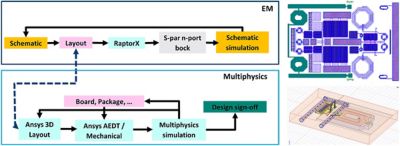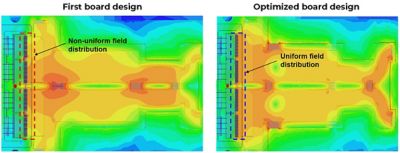Case Study
-
United States -
United Kingdom -
India -
France -
Deutschland -
Italia -
日本 -
대한민국 -
中国 -
台灣
-
Ansys는 학생들에게 시뮬레이션 엔지니어링 소프트웨어를 무료로 제공함으로써 오늘날의 학생들의 성장을 지속적으로 지원하고 있습니다.
-
Ansys는 학생들에게 시뮬레이션 엔지니어링 소프트웨어를 무료로 제공함으로써 오늘날의 학생들의 성장을 지속적으로 지원하고 있습니다.
-
Ansys는 학생들에게 시뮬레이션 엔지니어링 소프트웨어를 무료로 제공함으로써 오늘날의 학생들의 성장을 지속적으로 지원하고 있습니다.
“Deducing hard numbers for simulation’s return on investment differs per project and its complexity. However, ballpark figures are in the order of 70 % faster time to market and 40% cost savings.”
— Vittorio Cuoco, Senior Principal Engineer, Ampleon
For nearly 60 years, Dutch semiconductor company Ampleon has specialized in radio frequency (RF) power products, which are decreasing in size while increasing in complexity. The company’s vision is to advance society through innovative RF solutions, such as discrete devices, monolithic microwave integrated circuits (MMICs), laterally diffused metal-oxide semiconductor (LDMOS) technology, and gallium nitride (GaN) devices.
Challenges
With such a wide array of offerings, the application frequencies span from a few tens of megahertz for broadcast applications to several gigahertz for the 4G and 5G infrastructure markets. Depending on the application, these products range from a few watts to kilowatt output power levels.
To achieve these power levels, multiple large dies are combined in a single package. These dies can be single transistors as well as integrated MMIC amplifiers. They are combined with other components like large metal-oxide MOS capacitors, which are also included in the package. The purpose of these components is to provide in-package impedance transformation and matching. The dies and the additional components are connected via bond wires, which are also used to connect the dies to the package leads and, thus, to external parts.
These bond wires not only serve the purpose of connection — they are design elements that are part of the impedance transformation and matching. As such, accurate prediction of their multiphysics behavior and their interaction with the dies and package leads are key challenges for optimizing device performance.
Moreover, the need to reduce sizes requires packing many components into a limited space, leading to increased temperatures. Making sure that high temperatures and related mechanical stress levels remain under reliability limits is challenging.

In Ampleon’s electromagnetic and multiphysics design flow, a first-order simulation is performed at the schematic level, then the generated layout is simulated in Ansys RaptorX™ to create an S-parameter block for a new schematic simulation. The layout is imported into Ansys Electronics Desktop™ for Ansys Mechanical™ system-level multiphysics simulations.
Engineering Solutions
Ampleon engineers use the Ansys Electronics Desktop platform for EM, thermal, and mechanical simulations to analyze and optimize the EM performance of packaged and integrated devices as well as complete systems under real-life operating conditions. It is also used for electro-thermo-mechanical multiphysics integrated flow, in which the dissipations calculated by the EM solver are used as loads by the thermal solver. Those results are, in turn, used as loads by the mechanical solver. EM-circuit co-simulations are sometimes also used to account for realistic loading and operating conditions.
Ampleon engineers also use Ansys structural simulation solutions when more sophisticated material or simulation models are required. In these cases, the integration is via the Workbench interface. The Workbench platform enables Ampleon engineers to feed mechanical simulation results back to the EM solver and calculate the effect of the thermally induced deformations on the EM performance of their products.
Ampleon enigneers use Icepak software to investigate and optimize cooling methodologies at the package, board, and system levels, and they utilize RaptorX software to optimize the EM performance of advanced MMIC products.

Electromagnetic simulations with Ansys Electronics Desktop™ help Ampleon identify measures to reduce the input-to-output coupling in packaged devices. This coupling is often due to the magnetic field generated by the wires at the output which flow through the wires at the input. A possible solution is to add “guard” wires at the side of the transistor to reduce the outflowing field. This patented solution significantly reduces coupling.

Electromagnetic simulations with Ansys Electronics Desktop™ software enable Ampleon engineers to optimize printed circuit board designs to ensure that field distribution is uniform.
Benefits
Ansys simulations enable Ampleon to optimize the operational efficiency of their products by ensuring the proper ratio of power delivered to power consumed is met. This enables customers to save on energy bills while supporting a more sustainable future.
System-level simulations also help Ampleon investigate and address potential reliability concerns arising from thermal hot spots or high stress levels. Being able to do this early in the design phase enables the company to reduce costs and time to market by avoiding costly and time-consuming redesigns.
“Ansys tools, with their accurate electromagnetic and multiphysics simulations, are a must-have to tackle these challenges at multiscale levels, including chip, package, board, and cooling blocks,” says Vittorio Cuoco, senior principal engineer at Ampleon.

Ansys multiphysics simulations help Ampleon engineers visualize temperature distributions at the system level and ensure that values remain within the safe limits.
시작하기
엔지니어링 과제에 직면하고 있다면우리 팀이 도와드리겠습니다. 풍부한 경험과 혁신에 대한 헌신을 가지고 있는 우리에게 연락해 주십시오. 협력을 통해 엔지니어링 문제를 성장과 성공의 기회로 바꾸십시오. 지금 문의하기










